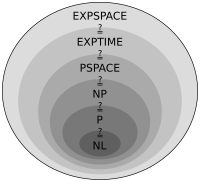Complexity classes

Okay kiddo, do you know what a computer is and how it works? Well, when we tell a computer to do something, like solve a math problem, it follows a series of instructions called an algorithm. Some algorithms are really easy for the computer to follow, and it can solve the problem really quickly. Other algorithms are really hard for the computer, and it takes a really long time to figure out the answer.
Scientists have come up with something called complexity classes to help us understand how hard or easy it is for a computer to solve different problems. One complexity class is called P, which stands for polynomial time. These are problems that a computer can solve relatively quickly, and the amount of time it takes the computer to solve the problem increases slowly as the problem gets bigger.
Another complexity class is called NP, which stands for non-deterministic polynomial time. These problems are harder for the computer, and it may take a really long time to find the answer. But once the answer is found, it is easy to check if it is correct or not.
There is also a complexity class called NP-complete, which is made up of the hardest problems that a computer can solve in a reasonable amount of time. Scientists have been trying to figure out if there is a way to solve these NP-complete problems more efficiently, but so far it is still a big mystery.
So, basically, complexity classes help us understand how hard or easy it is for a computer to solve different problems, and P, NP, and NP-complete are three important classes that we use to categorize these problems.
Scientists have come up with something called complexity classes to help us understand how hard or easy it is for a computer to solve different problems. One complexity class is called P, which stands for polynomial time. These are problems that a computer can solve relatively quickly, and the amount of time it takes the computer to solve the problem increases slowly as the problem gets bigger.
Another complexity class is called NP, which stands for non-deterministic polynomial time. These problems are harder for the computer, and it may take a really long time to find the answer. But once the answer is found, it is easy to check if it is correct or not.
There is also a complexity class called NP-complete, which is made up of the hardest problems that a computer can solve in a reasonable amount of time. Scientists have been trying to figure out if there is a way to solve these NP-complete problems more efficiently, but so far it is still a big mystery.
So, basically, complexity classes help us understand how hard or easy it is for a computer to solve different problems, and P, NP, and NP-complete are three important classes that we use to categorize these problems.
